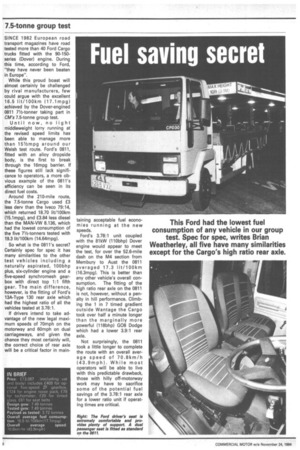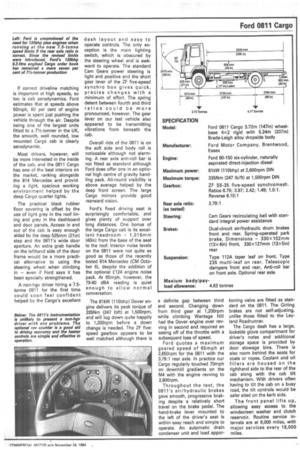This Ford had the lowest fuel consumption of any vehicle
Page 42

Page 43

If you've noticed an error in this article please click here to report it so we can fix it.
in our group test. Spec for spec, writes Brian Weatherley, all five have many similarities except for the Cargo's high ratio rear axle. 7.5-tonne group test
SINCE 1982 European road transport magazines have road tested more than 40 Ford Cargo trucks fitted with the 90-150series (Dover) engine. During this time, according to Ford, "they have never been beaten in Europe".
While this proud boast will almost certainly be challenged by rival manufacturers, few could argue with the excellent 16.5 lit/100km (17.1mpg) achieved by the Dover-engined 0811 71/2-tonner taking part in CM'S 7.5-tonne group test.
Until now, no light middleweight lorry running at the revised speed limits has been able to manage more than 151/2mpg around our Welsh test route. Ford's 0811, fitted with an alloy dropside body, is the first to break through the 16mpg barrier. If these figures still lack significance to operators, a more obvious example of the 0811's efficiency can be seen in its direct fuel costs.
Around the 210-mile route, the 7.5-tonne Cargo used E3 less dery than the lveco 79:14, which returned 18.70 lit/100km (15.1mpg), and £3.84 less diesel than the MAN-VW 8.136, which had the lowest consumption of the five 71/2-tonners tested with 19.3 lit/100km (14.64mpg).
So what is the 0811's secret? Certainly spec for spec it has many similarities to the other test vehicles including a naturally aspirated, 100bhp plus, six-cylinder engine and a five-speed synchromesh gearbox with direct top 1:1 fifth gear. The main difference, however, is the fitting of Ford's 13A-Type 130 rear axle which had the highest ratio of all the vehicles tested at 3.78:1.
If drivers intend to take advantage of the new legal maximum speeds of 70mph on the motorway and 60mph on dual carriageways, and given the chance they most certainly will, the correct choice of rear axle will be a critical factor in main taming acceptable fuel economies running at the new speeds.
Ford's 3.78:1 unit coupled with the 81kW (110bhp) Dover engine would appear to meet the test, for over the 52.6-mile dash on the M4 section from Membury to Aust the 0811 averaged 17.3 lit/100km (16.3mpg). This is better than any other vehicle's overall con sumption. The fitting of the high ratio rear axle on the 0811 is not, however, without a penalty in hill performance. Climbing the 1 in 7 timed gradient outside Wantage the Cargo took over half a minute longer than the marginally more powerful (118bhp) G08 Dodge which had a lower 3.9:1 rear axle.
Not surprisingly, the 0811 took a little longer to complete the route with an overall average speed of 70.8km/h (43.9mph). While most operators will be able to live with this predictable drawback, those with hilly off-motorway work may have to sacrifice some of the potential fuel savings of the 3.78:1 rear axle for a lower ratio unit if operating times are critical. If correct driveline matching is important at high speeds, so too is cab aerodynamics. Ford estimates that at speeds above 50mph, 60 per cent of engine power is spent just pushing the vehicle through the air. Despite being one of the largest units fitted to a 71/2-tonner in the UK, the smooth, well rounded, low mounted Cargo cab is clearly aerodynamic.
Most drivers, however, will be more interested in the inside of the cab, and the 0811 Cargo has one of the best interiors on the market, ranking alongside the 814 Mercedes and providing a light, spacious working environment helped by the deep Cargo quarter lights.
The practical black rubber floor covering is offset by the use of light grey in the roof lining and grey in the dashboard and door panels. Access in and out of the cab is easy enough aided by the deep 525mm (21in) step and the 0811's wide door aperture. An extra grab handle on the lefthand side of the door frame would be a more practical alternative to using the steering wheel when climbing in — even if Ford says it has been specially strengthened.
A non-hgv driver hiring a 7.5tonne 0811 for the first time could soon feel confident helped by the Cargo's excellent dash layout and easy to operate controls. The only exception is the main lighting switch, which is obscured by the steering wheel and is awkward to operate. The standard Cam Gears power steering is light and positive and the short gear lever of the ZF five-speed synchro box gives quick, precise changes with a minimum of effort. The spring detent between fourth and third ratios could be more pronounced, however. The gear lever on our test vehicle also appeared to be transmitting vibrations from beneath the cab.
Overall ride of the 0811 is on the soft side and body roll is noticeable although not alarming. A rear axle anti-roll bar is not fitted as standard although Ford does offer one in an optional high centre of gravity handling pack. All-round visibility is above average helped by the deep front screen. The large Cargo mirrors provide good rearward vision.
Ford's fixed driving seat is surprisingly comfortable, and gives plenty of support over long distances. One bonus of the large Cargo cab is its excellent headroom — 1,016mm (40in) from the base of the seat to the roof. Interior noise levels on the 0811 were not quite as good as those of the recently tested 814 Mercedes (CM October 6), despite the addition of the optional E124 engine noise pack. At 65mph, however, the 79-80 dBA reading is quiet enough to allow normal conversation.
The 81kW (110bhp) Dover engine delivers its peak torque of 335Nm (247 lbft) at 1,500rpm, and will lug down quite happily to 1,200rpm before a down change is needed. The ZF fivespeed gearbox appears to be well matched although there is a definite gap between third and second. Changing down from third gear at 1,200rpm while climbing Wantage Hill had the Dover engine over revving in second and required an easing off of the throttle with a subsequent loss of speed.
Ford quotes a maximum geared speed of 65mph at 2,650rpm for the 0811 with the 3.78:1 rear axle. In practice our Cargo regularly touched 70mph on downhill gradients on the M4 with the engine revving to 2,90Orpm.
Throughout the test, the 0811's air/hydraulic brakes gave smooth, progressive braking despite a relatively short travel on the brake pedal. The hand-brake lever mounted to the left of the driver's seat is within easy reach and simple to operate. An automatic drain condenser unit and load appor
tioning valve are fitted as standard on the 0811. The Girling brakes are not self-adjusting, unlike those fitted to the Leyland Roadrunner.
The Cargo dash has a large, lockable glove compartment for driver's notes and additional storage space is provided by door stowage bins. There is also room behind the seats for coats or ropes. Coolant and oil fillers are housed on the rig hthand side to the rear of the cab along with the cab tilt mechanism. With drivers often having to tilt the cab on a busy road, the tilt controls would be safer sited on the kerb side.
The front panel lifts up, allowing easy access to the windscreen washer and clutch reservoir. Routine service intervals are at 6,000 miles, with major services every 18,000 miles.
































































































